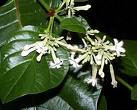Teazle has a long history in Europe, not because of its medicinal properties, but because of its use in the cloth-making industry. It is a relation of the thistles so is allied with the milk-thistle and the globe artichoke. It is a tall plant, growing to about 5 feet and depending on the genus has white, pink or lilac coloured flowers. It has large leaves around the middle and base of the plant, which are capable of holding dew and rain water, which was used to cleanse the face and as eyewash, as the water retained in the leaves was thought to have medicinal properties. The teasel cutters of old would drink this water to stimulate their appetites as well as to quench thirst. Because of its cosmetic use, it was called Venus’ Basin. The botanical name Dipsacus comes from the Greek dipsos meaning to be thirsty.
 It is native to Europe, West Asia and North Africa and there are 15 or so species growing around the world. In Britain there are the three listed in the title of this post. Teazels are naturalized in North America.
It is native to Europe, West Asia and North Africa and there are 15 or so species growing around the world. In Britain there are the three listed in the title of this post. Teazels are naturalized in North America. The roots of the plant have been used in decoctions and infusions to get rid of warts, and to stimulate the appetite and as a diuretic. However the first year’s growth of the roots and leaves are preferred.
 Dioscorides, writing in the first century AD recommended that the roots could be made into an ointment for all skin eruptions, including cancerous tumours. It has also been used for jaundice and blockages of the liver.
Dioscorides, writing in the first century AD recommended that the roots could be made into an ointment for all skin eruptions, including cancerous tumours. It has also been used for jaundice and blockages of the liver. Birds feed on the seeds which come from the head of the teasel, and one plant can produce up to 2,000 seeds, so they can really feast on them.
Teazles can be dried and used in dried flower arrangements, either as they are or painted (you can do this with a glossy nail varnish or with a spray).
Teazles were employed in the cloth-making industry at least as far back as the Middle Ages, as they are mentioned in John Langland’s “Piers Plowman” of 1377. A rough translation is this: -
 “Cloth that comes from the weaving is in no way good to wear until it is fulled… and with the teazel scratched.”
“Cloth that comes from the weaving is in no way good to wear until it is fulled… and with the teazel scratched.” It was cultivated in Europe in the Middle Ages for use in this industry and was used by some manufacturers in the twentieth century. It was dried in “helms” (open sheds) in some English counties, which were made with the stalks of teazel.
Gerard writing in 1597in his “Herball” distinguished between the wild teazel (Dipsacus sylvestris) and Dipsacus sativa, or garden teasel in this way, “the tame teasell is grown in gardens to serve the use of the fuller and clothworkers.” Culpeper, in his usual forthright way calls garden teasel “manured” but he called this Dipsacus fullonum and says that it has “prickly hooks”, whereas the wild form has straight spines.
Children used to use the teazel heads to comb the hair of their dolls and in earlier times it was used to get knots out of hair and beards, giving rise to other old names, Brushes and Combs and Barber’s Brush.
If you pick any teazel, be sure to wear gloves, as the thorns can be painful, and the skin can be irritated by the plant. It is included here for interest’s sake only.















